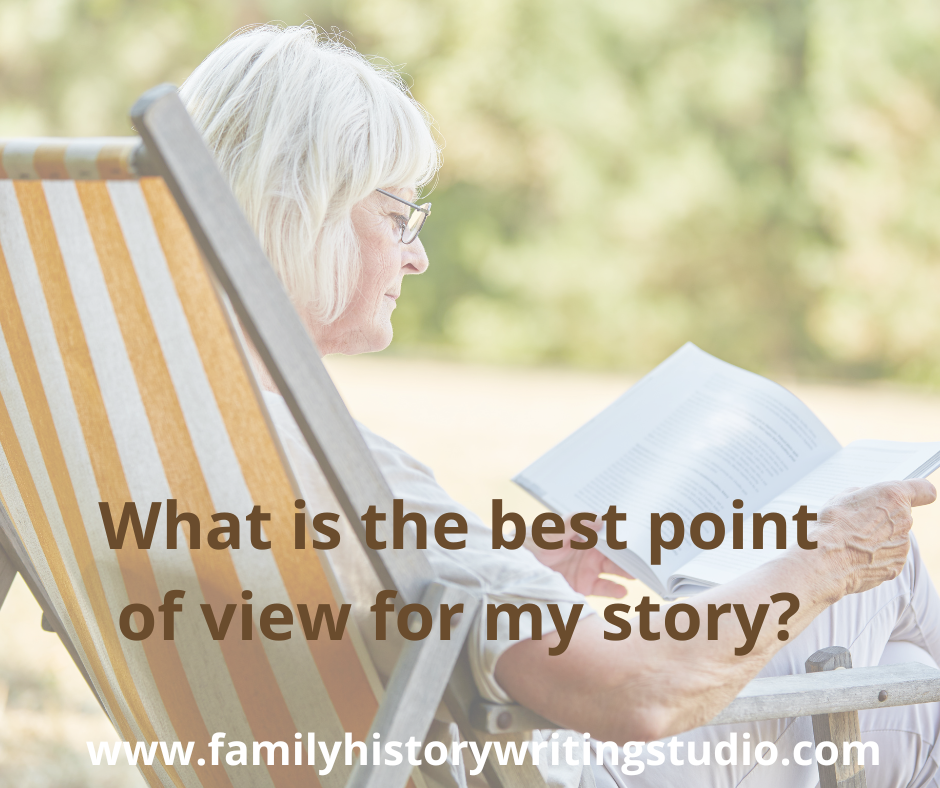Today, let’s delve into an important topic that will truly elevate your storytelling skills – point of view. Discover the point of view that is most suited to writing family history stories and learn all about its superpowers. Join us for this enlightening lesson and unlock the secrets of creating multi-dimensional masterpieces.
What is the best point of view for my family history story?

4 thought on “What is the best point of view for my family history story?”
Comments are closed.
Related Post

Make Your Scenes Pop!Make Your Scenes Pop!
Do your stories pop?
Do they engage your reader and give them a vision in their mind through the words you’ve strung together on the page. As writers, our goal is to create clear and detailed images through the use of descriptive language. If you’re not using descriptive writing in your family history stories then you are missing an opportunity to show rather than tell. Descriptive writing adds texture, colour and dimension to our stories. It is how we make reading a sensory experience for our readers.
My favourite quote that helps to illustrate showing in scenes remains:
“DON’T TELL ME THE MOON IS SHINING; SHOW ME THE GLINT OF LIGHT ON BROKEN GLASS.”
ANTON CHEKHOV
As we discussed in How to Write a Scene, detailed description, imagery and figurative language are components of a scene that we heavily rely on to make a scene vivid and in full colour for the reader. Today’s post pulls together a few tips to help you improve your use of description in writing your scenes.
Use all of your senses.
As we mentioned in How to Write a Scene using your senses is an essential ingredient of descriptive writing. Using the senses of touch, taste, hearing, seeing and smelling are all equally important in bringing your ancestor’s experience to life on the page. We often tend only to use sight, but employing a combination of senses gives your reader a much deeper experience.
Avoid Clichés
Clichés are words or expressions that have been overused. They may have been original at one time but through overuse they have become clichés. Be aware of them and find fresh and original ways to describe your story. Some examples of clichés include dead as a doornail, smart as a whip, sweet as sugar. You get the idea.
Use a Thesaurus
Try to avoid using the same words in a sentence, paragraph or, if it is an uncommon word, in the story, unless the word is used for effect. This applies to standard words and less common words. Use a thesaurus to find alternative words that convey the same meaning. (I used the word “word” eight times – did you notice?)
Use Personification, Similes, and Metaphors
Personifications, similes, and metaphors can add sensuous references vividly, explain things, express emotion and entertain your reader. They add richness to your writing and show an image in a vibrant way through example rather than tell directly. They should replace, enhance or define adjectives like, beautiful, sweet, picturesque and others. We’ve all learned about similes and metaphors in school. Perhaps, it’s time for a refresher course, and a little practice to help you see just how important it can be in writing your family history stories.
Let’s take a look at each with examples from the memoir Glass Castle by Jeannette Walls.
Personification
Personification adds human personality traits to inanimate objects.
“Finally, we entered hill country, climbing higher and deeper into the Appalachian Mountains, stopping from time to time to let the Oldsmobile catch its breath.”
Simile
A simile ties two things together using the words ‘as’ or ‘like.’
“ It was like sewing meat. It was sewing meat.” Mr. Walls gets beat up and asks for Jeannette to sew up a gash on his arm.
Metaphor
Metaphors are figurative comparisons that describe one thing by directly assigning it the traits of another, so one idea is understood in terms of the other.
Rex says Maureen “is a sick puppy, the runt of the litter, who should have been drowned at birth”
This statement expresses how Rex feels Maureen is weak and dependent, and the rest of the family has to provide for her.
Don’t Over Do it!
Beginning writers tend to lack confidence in writing description in those early days, but once they gain an understanding of description, they can then go too far and overdo it. As I mentioned in writing a scene, too much detail can completely overtake a story and it bears repeating again. Once we get the handle on description and detail we tend to find a reason to think more is better. It is not. As the artist of this work you must make decisions about which descriptions and details serve the story best, the feeling you want to portray on the page. Description should enhance your characters and their world, not overwhelm it.
Is Your Family History Story Stuck?Is Your Family History Story Stuck?
Watch this video and grab the tool.
Is your family history story stuck? It doesn’t have to be. Sometimes we lose our way and our family history stories get stuck. In today’s video, learn about the number one tool to help you get your story moving forward again.
Watch the video and grab the tool.

Wow, how very enlightening.
Thanks for this talk about POV, Lynn.
I’m attempting to write my next family history book from 1st person point of view, to let the characters tell their own stories.
Do you know of a family history writer who has done this effectively ?
Hi Michael, if you are entering into first person, and not from your point of view (that would be memoir) but from your ancestor then this leaves the creative nonfiction genre and would be classified as fiction.
Thank you for creating these lessons about writing. Creating the family tree and family story is quite a project and the twists and turns happen unexpectedly, so this helps to keep me on track. Wish I could attend your retreat, but it doesn’t work out this year.